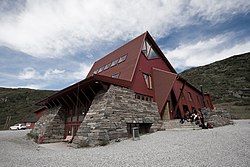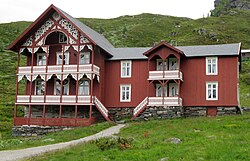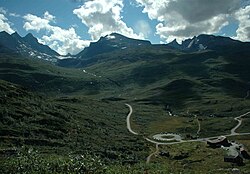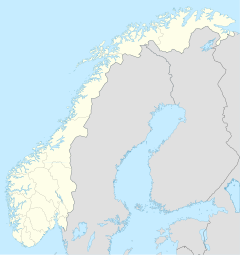| Turtagrø | |
|---|---|
 Turtagrø, the new hotel building from 2002 | |
| General information | |
| Location | Luster, Norway |
| Opening | 1888 |
| Website | |
| http://www.turtagro.no/ | |
Turtagrø is a hotel in the municipality of Luster in Vestland county, Norway, near Hurrungane in Jotunheimen. The hotel has been a central meeting place for mountaineers from the late 1800s.
Location
Turtagrø is located near the old mountain route and current road Sognefjellsvegen, north of Hurrungane in Jotunheimen. [1] It can be a starting point for hiking tours to Fannaråken, Skogadalsbøen and the peaks and ridges of Hurrungane, including climbing the Store Skagastølstind. [2] [3]
History

The first hotel at Turtagrø was built in 1888 by mountain guide Ola Berge. Later the same year a second hotel was built by Ole Øiene, only 100 metres apart. Turtagrø was a central meeting place for the pioneers of mountaineering in Jotunheimen from the late 1800s, and among the early visitors were William Cecil Slingsby, Howard Priestman and Carl Hall. The two hotels merged in 1911, when Berge bought the other hotel from Øiene. After Berge's death in 1928, his daughter Kari Berge was running the hotel. [4] The road Sognefjellsvegen, which passes Turtagrø, was finished in 1938. In 1938 the climbing association Norsk Tindeklub also built their own cabin in Skagadalen, and these events eventually contributed to a change in Turtagrø's role and the type of visitors. [5]


On 28 April 1940, during the closing days of the Norwegian Campaign in South Norway, German prisoners of war from the Norwegian 2nd Division's abandoned Lom prisoner of war camp and their guards arrived at Turtagrø. The prisoners and guards spent the night at Turtagrø on their way west to Vadheim in Sogn. The weakest of the prisoners were left under guard at the hotel, later to be retrieved by snow sleds. [6]
From 1953 the hotel was run by Johannes Drægni. In 1962 Drægni established the first climbing school in Norway, Den Norske Klatreskole, [7] at Turtagrø. [8] The climbing school operated until 1975. [8] Ole Berge Drægni was running the hotel from 1997. [9] In 2001 the old main building burned down in a fire. A new hotel building opened in 2002. [10] [11] Ole Berge Drægni perished in the tsunami in Thailand in 2004, and his then four-year-old daughter Sofie inherited the majority of the stocks. [11] [12]
References
- ^ Evensen, Knut Harald, ed. (2006). NAF Veibok 2007-2009 (in Norwegian). Oslo: Norges Automobil-Forbund. p. 369.
- ^ Bloch-Hoell, Niels, ed. (2005). Til fots i Norge (in Norwegian). Oslo: Den norske Turistforening. pp. 184–205.
- ^ Thommessen; Skogheim; Kuyper 1995, pp. 44-45, 59-60
- ^ Thommessen; Skogheim; Kuyper 1995, p. 59-60
- ^ Lauritzen 1997, p. 68-69
- ^ Mølmen 1996, p. 327
- ^ Thommessen; Skogheim; Kuyper 1995, p. 59-60
- ^ a b "NKFs historie" (in Norwegian). Norges Klatreforbund. Archived from the original on 3 March 2012. Retrieved 15 September 2011.
- ^ Lauritzen 1997, p. 68-69
- ^ "Turtagrø". Store norske leksikon (in Norwegian). Oslo: Kunnskapsforlaget. Retrieved 8 September 2011.
- ^ a b "Turtagrø. Historie" (in Norwegian). Turtagrø Hotel. Archived from the original on 26 July 2011. Retrieved 8 September 2011.
- ^ Viki, Kaia Johnsen; Hjetland, Geir Bjarte. "Sofie var fire år då pappa døydde i tsunamien – no blir ho 18 og fører arven vidare". NRK (in Norwegian). Retrieved 22 July 2018.
Bibliography
- Mølmen, Øystein (1996). Krigen 1940–45 (in Norwegian). Lesjaskog: Ø. Mølmen. ISBN 82-993958-0-1.
- Thommessen; Skogheim; Kuyper (1995). Fra Rondslottet til Lodalskåpa (in Norwegian). Fagernes: Valdres Forlag. ISBN 82-7562-037-6.
- Lauritzen, Per Roger (1997). Hyttene i Jotunheimen (in Norwegian). Boksenteret. ISBN 82-7683-139-7.
| Turtagrø | |
|---|---|
 Turtagrø, the new hotel building from 2002 | |
| General information | |
| Location | Luster, Norway |
| Opening | 1888 |
| Website | |
| http://www.turtagro.no/ | |
Turtagrø is a hotel in the municipality of Luster in Vestland county, Norway, near Hurrungane in Jotunheimen. The hotel has been a central meeting place for mountaineers from the late 1800s.
Location
Turtagrø is located near the old mountain route and current road Sognefjellsvegen, north of Hurrungane in Jotunheimen. [1] It can be a starting point for hiking tours to Fannaråken, Skogadalsbøen and the peaks and ridges of Hurrungane, including climbing the Store Skagastølstind. [2] [3]
History

The first hotel at Turtagrø was built in 1888 by mountain guide Ola Berge. Later the same year a second hotel was built by Ole Øiene, only 100 metres apart. Turtagrø was a central meeting place for the pioneers of mountaineering in Jotunheimen from the late 1800s, and among the early visitors were William Cecil Slingsby, Howard Priestman and Carl Hall. The two hotels merged in 1911, when Berge bought the other hotel from Øiene. After Berge's death in 1928, his daughter Kari Berge was running the hotel. [4] The road Sognefjellsvegen, which passes Turtagrø, was finished in 1938. In 1938 the climbing association Norsk Tindeklub also built their own cabin in Skagadalen, and these events eventually contributed to a change in Turtagrø's role and the type of visitors. [5]


On 28 April 1940, during the closing days of the Norwegian Campaign in South Norway, German prisoners of war from the Norwegian 2nd Division's abandoned Lom prisoner of war camp and their guards arrived at Turtagrø. The prisoners and guards spent the night at Turtagrø on their way west to Vadheim in Sogn. The weakest of the prisoners were left under guard at the hotel, later to be retrieved by snow sleds. [6]
From 1953 the hotel was run by Johannes Drægni. In 1962 Drægni established the first climbing school in Norway, Den Norske Klatreskole, [7] at Turtagrø. [8] The climbing school operated until 1975. [8] Ole Berge Drægni was running the hotel from 1997. [9] In 2001 the old main building burned down in a fire. A new hotel building opened in 2002. [10] [11] Ole Berge Drægni perished in the tsunami in Thailand in 2004, and his then four-year-old daughter Sofie inherited the majority of the stocks. [11] [12]
References
- ^ Evensen, Knut Harald, ed. (2006). NAF Veibok 2007-2009 (in Norwegian). Oslo: Norges Automobil-Forbund. p. 369.
- ^ Bloch-Hoell, Niels, ed. (2005). Til fots i Norge (in Norwegian). Oslo: Den norske Turistforening. pp. 184–205.
- ^ Thommessen; Skogheim; Kuyper 1995, pp. 44-45, 59-60
- ^ Thommessen; Skogheim; Kuyper 1995, p. 59-60
- ^ Lauritzen 1997, p. 68-69
- ^ Mølmen 1996, p. 327
- ^ Thommessen; Skogheim; Kuyper 1995, p. 59-60
- ^ a b "NKFs historie" (in Norwegian). Norges Klatreforbund. Archived from the original on 3 March 2012. Retrieved 15 September 2011.
- ^ Lauritzen 1997, p. 68-69
- ^ "Turtagrø". Store norske leksikon (in Norwegian). Oslo: Kunnskapsforlaget. Retrieved 8 September 2011.
- ^ a b "Turtagrø. Historie" (in Norwegian). Turtagrø Hotel. Archived from the original on 26 July 2011. Retrieved 8 September 2011.
- ^ Viki, Kaia Johnsen; Hjetland, Geir Bjarte. "Sofie var fire år då pappa døydde i tsunamien – no blir ho 18 og fører arven vidare". NRK (in Norwegian). Retrieved 22 July 2018.
Bibliography
- Mølmen, Øystein (1996). Krigen 1940–45 (in Norwegian). Lesjaskog: Ø. Mølmen. ISBN 82-993958-0-1.
- Thommessen; Skogheim; Kuyper (1995). Fra Rondslottet til Lodalskåpa (in Norwegian). Fagernes: Valdres Forlag. ISBN 82-7562-037-6.
- Lauritzen, Per Roger (1997). Hyttene i Jotunheimen (in Norwegian). Boksenteret. ISBN 82-7683-139-7.

